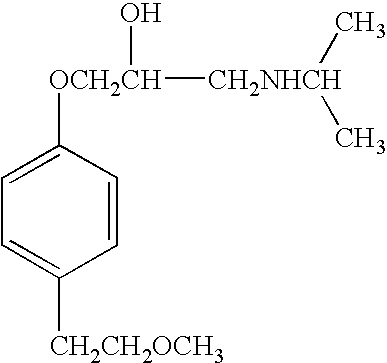Method to prepare microparticles metoprolol that contain
a technology of metoprolol and microparticles, which is applied in the field of preparing homogeneous microparticles of metoprolol, can solve the problems of toxicity of the solvent used, difficulty in achieving acceptable microparticles, and insufficient mechanical strength of existing techniques, so as to achieve sufficient mechanical strength and low friability
- Summary
- Abstract
- Description
- Claims
- Application Information
AI Technical Summary
Benefits of technology
Problems solved by technology
Method used
Image
Examples
example 1
[0068] Preparation of Particles
[0069] Microparticles were prepared in a continuous fluidized bed system (Glatt AGT 150, Weimar, Germany) from a solution of metoprolol succinate. The solution was done by dissolving metoprolol succinate (750 g) into warm water (68.degree. C.) (1250 g). Solid content of the suspension was 37.5% w / w. The solution (37.5 w / w % metoprolol succinate) was kept in 68.degree. C. before further processing.
[0070] The solution was warmed up to 75.degree. C. and sprayed into a Glatt AGT 150 fluidized bed with a flow rate of 30 g / min. The nozzle had a opening of 0.5 mm. The inlet air flow was approximately 110 m.sup.3 / h, inlet air temperature 110.degree. C., atomizing air pressure 4 bar, sifter air pressure 75-76 mbar and sifter air flow 1.42 m.sup.3 / h. Median size of the uncoated particles was 149 .mu.m, 90% smaller than 182 .mu.m and 10% smaller than 113 .mu.m when determined by laser diffractometry. Estimated from scanning electron micrographs, pores on the surf...
example 2
[0077] Preparation of Particles
[0078] Microparticles were prepared in a continuous fluidized bed system (Glatt AGT 150, Weimar, Germany) from a solution of metoprolol succinate. The solution was done by dissolving metoprolol succinate (938 g) into warm water (68.degree. C.) (1562 g). Solid content of the suspension was 37.5% w / w. The solution (37.5 w / w % metoprolol succinate) was kept in 68.degree. C. before further processing.
[0079] The solution was warmed up to 75.degree. C. and sprayed into a Glatt AGT 150 fluidized bed with a flow rate of 30 g / min. The nozzle had a opening of 0.5 mm. The inlet air flow was approximately 100 m.sup.3 / h, inlet air temperature 100.degree. C., atomizing air pressure 4.8 bar and sifter air flow 1.49 m.sup.3 / h. Median size of the uncoated particles was 118 .mu.m, 90% smaller than 147 .mu.m and 10% smaller than 88 .mu.m when determined by laser diffractometry. Estimated from scanning electron micrographs, pores on the surface of the particles were small...
PUM
| Property | Measurement | Unit |
|---|---|---|
| Fraction | aaaaa | aaaaa |
| Percent by mass | aaaaa | aaaaa |
| Percent by mass | aaaaa | aaaaa |
Abstract
Description
Claims
Application Information
 Login to View More
Login to View More - R&D
- Intellectual Property
- Life Sciences
- Materials
- Tech Scout
- Unparalleled Data Quality
- Higher Quality Content
- 60% Fewer Hallucinations
Browse by: Latest US Patents, China's latest patents, Technical Efficacy Thesaurus, Application Domain, Technology Topic, Popular Technical Reports.
© 2025 PatSnap. All rights reserved.Legal|Privacy policy|Modern Slavery Act Transparency Statement|Sitemap|About US| Contact US: help@patsnap.com

